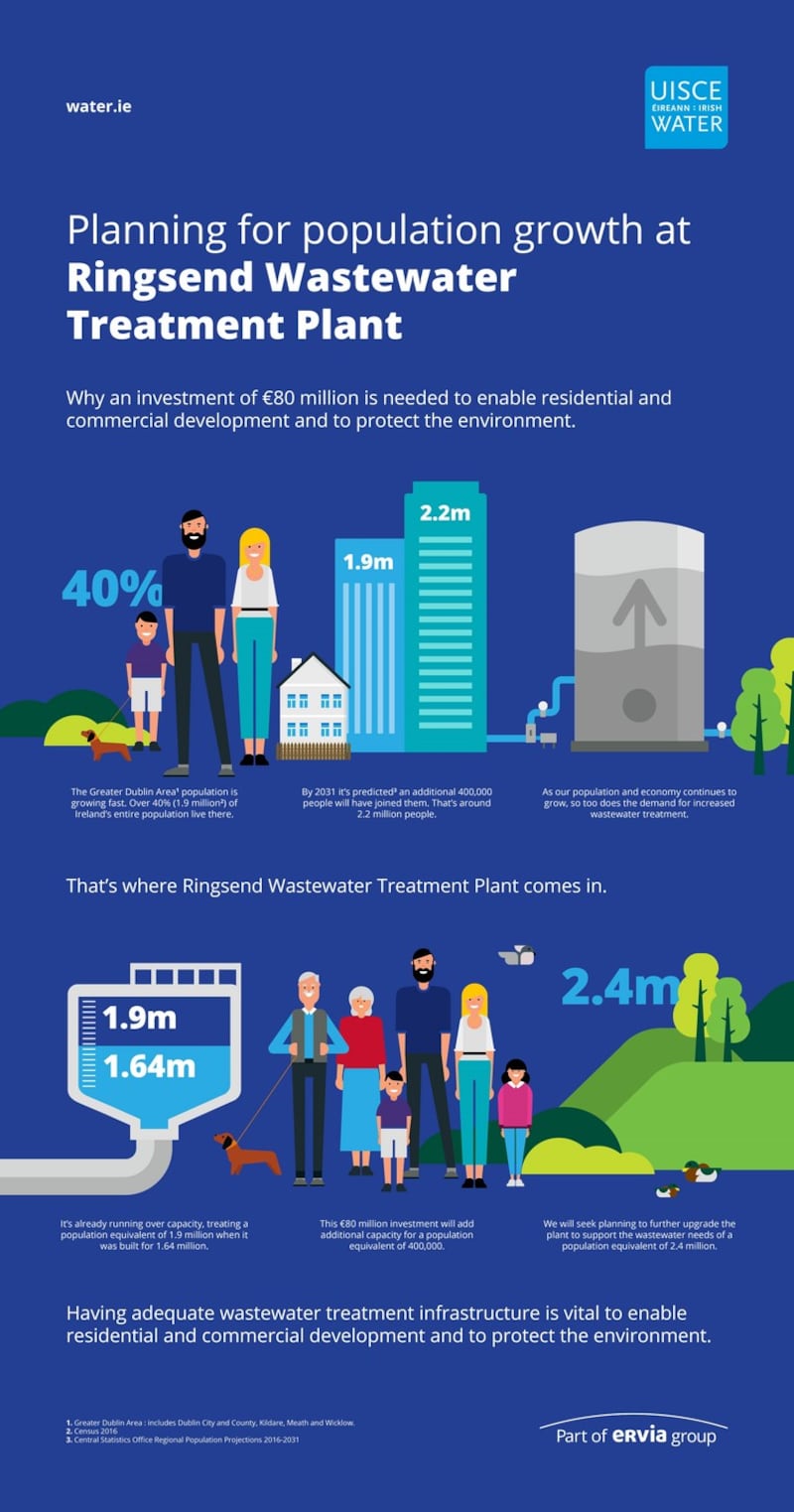Irish Water is commencing work on an €80 million upgrade to Ringsend Wastewater Treatment Plant with a view to increasing its capacity to cater for the population equivalent of an extra 400,000 people in the Dublin region.
It is the first part of a €400 million overhaul of what is the largest wastewater treatment facility in Ireland.
The utility is to adopt new treatment technology, which it has successfully tested and deployed in Co Cork. A previous plan to build a nine kilometre outfall tunnel to relocate discharge of treated effluent from the Ringsend Plant into Dublin Bay will not proceed.
In 2012, An Bord Pleanála granted permission to Dublin City Council to upgrade the plant, to increase its capacity based on technologies available at the time and to build the tunnel.
Revamp of the Ringsend plant may not be a sexy project like a new motorway or railway line
The Ringsend plant was built in 2005 to treat wastewater for the equivalent of 1.64 million people. Currently it services more than 40 per cent of the national population – treating wastewater for the equivalent of 1.9 million people and operating at 20 per cent over capacity.
Consequences
As a consequence, it has repeatedly failed to meet EU urban waste water standards for discharge of effluent, notably in relation to levels of polluting phosphates and nitrates. Odour issues repeatedly surfaced in its early years, though Irish Water, which took over responsibility for the plant in 2014, said odour issues have largely been addressed.
The upgrade will take about two years to construct and accommodate current demand, support planned housing and economic growth in the Dublin Region and improve the quality of treated wastewater discharged to the Liffey estuary.

Currently, the plant serves the Greater Dublin Area including the city centre and stretching to suburban areas such as Dalkey, Rathcoole, Clondalkin, Blanchardstown/Mulhuddart, Dublin Airport and Howth, as well as parts of Meath such as Dunboyne, Clonee and Ashbourne.
Subject to planning permission, the upgrade will enable full treatment of wastewater for the equivalent of 2.4 million people, and meet foreseeable development needs to at least 2025.
Irish Water managing director Jerry Grant said: "This is a priority project and is vital for future social and economic development in Dublin, for public health and for improving the waters and ecology of Dublin Bay."
A planning application will be submitted to An Bord Pleanála shortly to progress the upgrade “in the most cost effective, environmentally sensitive and timely manner”, he said.
Advanced technology
Irish Water identified an advanced, nutrient-reduction treatment technology known as Aerobic Granular Sludge (AGS) as the best option. "We are already using this technology in Shanbally and Clonakilty Wastewater treatment plant and have proven its suitability for the Ringsend plant," Mr Grant said.
The utility has already invested €70 million in upgrading the Ringsend plant. “This includes advance work to prepare the site for the upgrade, upgrades to the odour treatment facilities, trialling and proving of AGS technology and investigative works to inform the project,” Mr Grant said.
This year it will also be seeking planning permission for the Greater Dublin Drainage Scheme including a new wastewater treatment plant in Clonshaugh, "needed from 2025 to enable the northern and north western environs of the city to continue to grow into the future", and for the Shannon-to-Dublin water pipeline which will cost up to €2 billion.
Business group Dublin Chamber welcomed the upgrade. Chief executive Mary Rose Burke said: "Revamp of the Ringsend plant may not be a sexy project like a new motorway or railway line, but it is an example of the type of investments that are required to ensure that Dublin continues to function. Dublin's water infrastructure has suffered from massive underinvestment over the past 30 years."
![Irish Water managing director Jerry Grant: ‘[The project] is vital for future social and economic development in Dublin’](https://www.irishtimes.com/resizer/v2/BMBQBW64D665JKPQPLXUHGJQEM.jpg?auth=ed06eb0b762f7d87ee0bebb5db26dda7aa56b6812142414b20b6223b3491bbf1&smart=true&width=1024&height=576)








